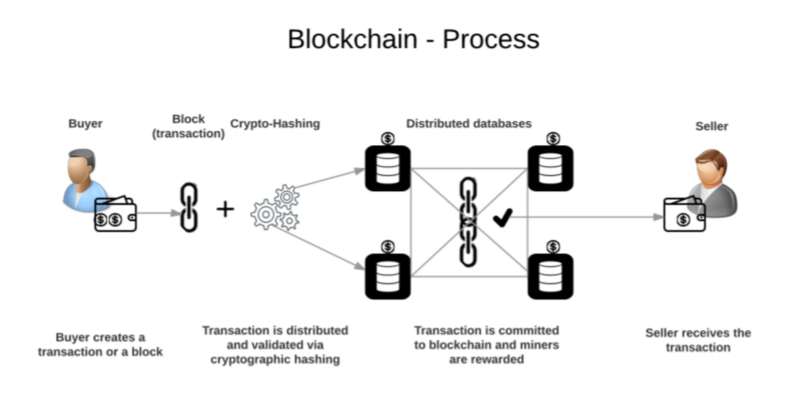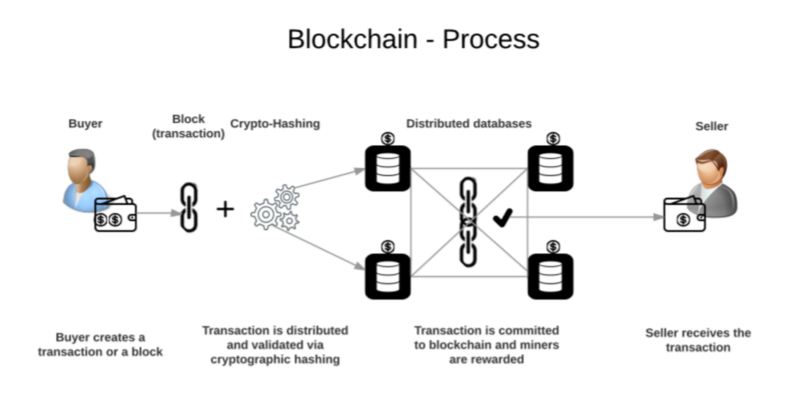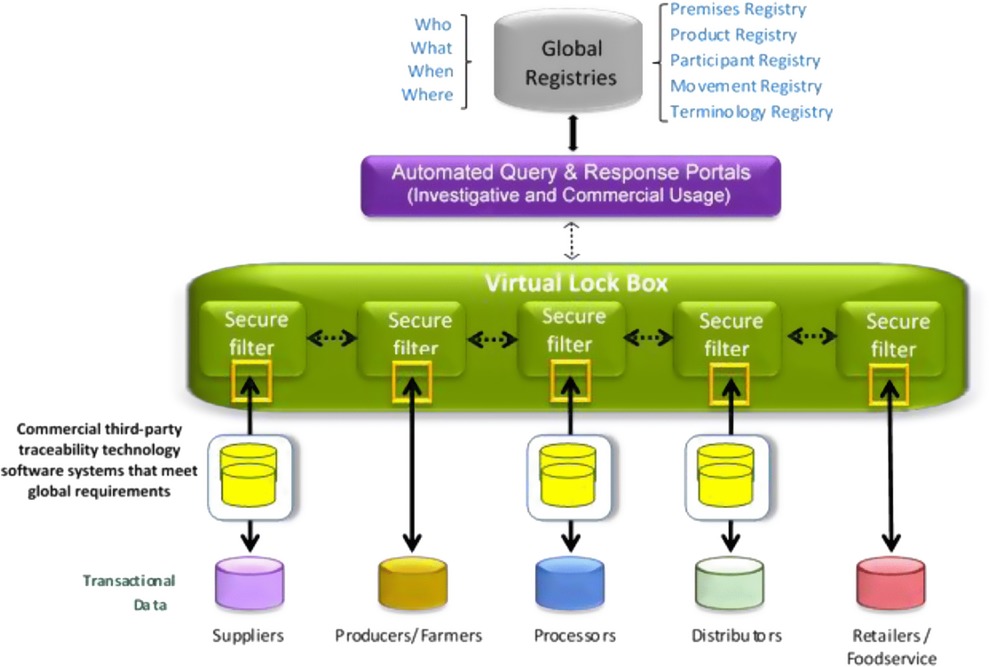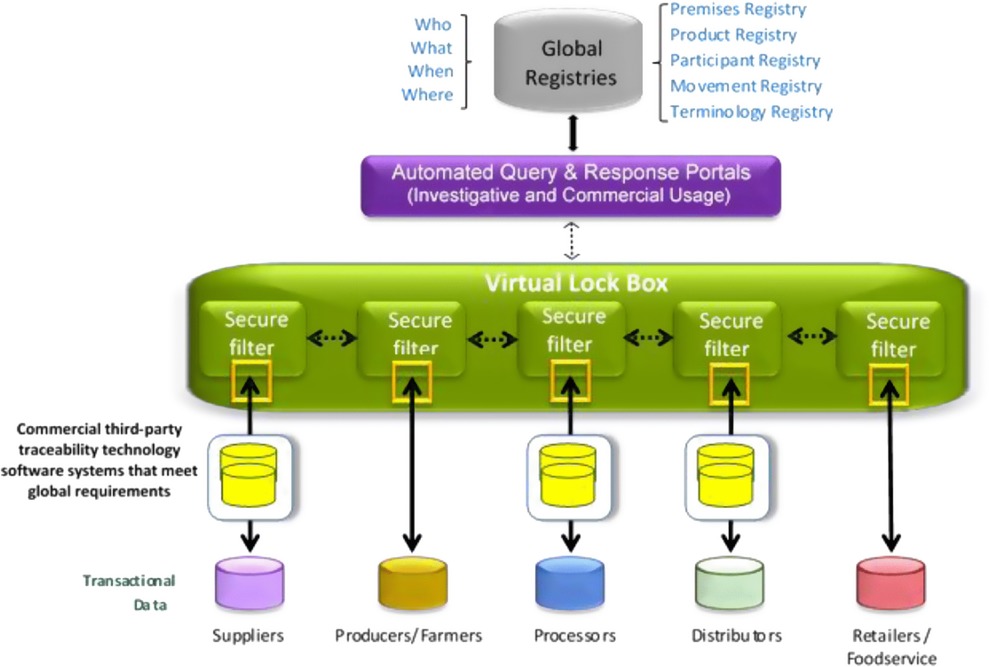
The Potential of Blockchain Technology Application in the Food System
Quick facts about the potential application of blockchain technology in our food system and how it can help solve challenges in food traceability.
Introduction
The popularity of Bitcoin and other blockchain technologies reached new heights in 2017. Bitcoin is the most prominent in a new type of currency, called cryptocurrency, where transactions are made without an established intermediary (i.e. banks). Cryptocurrencies have functionalities akin to other currencies but are not tied to a nation-state like conventional currencies. The underlying architecture, blockchain, is able to leverage the capability of a global, open network combined with cryptologic theory for generating a secure, trust-less means of exchanging value or information1,4. Blockchain technology has vast applications across many food industry areas, especially traceability, logistics, and finance 1,8.
Blockchain technology is a new iteration of an old concept. Ledgers are an inherent tool of business, and blockchain uses technology to improve on some of the disadvantages of private ledgers, namely by reducing reliance on external institutions in favor of cryptologic proof1,7,8. With blockchain distributed on a mutually shared network, all stakeholders of a supply chain can be on the same page with Key Data Elements (KDEs), the essential pieces of information to convey traceability goals.
What is Blockchain?
The term “blockchain” was first used by Satoshi Nakamoto, a pseudonymous person or entity, in a 2008 paper conceptualizing chronological blocks of data linked through a networked cryptologic chain4,5. The following year, Nakamoto created Bitcoin based on this concept1. Although the initial iteration of blockchain technologies concentrated on creating non-institutional currency, the technology is essentially a ledger with a wide potential of features, depending on the architecture1.
A blockchain uses hash-based cryptology to assure security and trust 4,5. A hash is an encrypted version of a string, or sequence of characters, wherein it is computationally impossible to derive the original without a key 5. The blockchain has three essential pieces of data: the transaction timestamp, transaction details, and a new hash combining the hash and details of the previous transaction5. Each transaction is then distributed throughout the network4,5. Through this process, a continuous encrypted record of the transaction is kept and becomes immutable once added to the blockchain4,5.
To verify changes to the blockchain, a resolving algorithm audits the pending transaction after which it is then distributed throughout the network to the shared ledger3. Once a transaction has become finalized through this validation process, it becomes a permanent part of the chain. The nodes at which transactions are verified known as “miners”4,5. Blockchain architectures primarily differ in their choice in resolving algorithms3. Some algorithms prioritize decentralization and anonymity while other prioritize throughput and rapidity3.
Users of the blockchain have two keys: private and public. The public key is the means for sending material to a specific individual on the blockchain. The private key authenticates transactions from the individual holder.
Blockchain in Supply Chains and Food Traceability Systems
Although most blockchain applications have been devoted to cryptocurrency exchange, the framework can theoretically be applied to any scenario requiring assured/verified information 1. The technology has heavy interest among financial and supply chain technology companies, for its ability to rely on peer-to-peer networks rather than centralized institutions1. By having a more transparent and decentralized system, companies along the supply chain will be able to input data into the system with a degree of anonymity and control that may spur universal adoption8. Data verification derived from its cryptologic structure is another attractive quality of blockchain systems8.
The value of blockchain use in traceability systems is predicated on the rapidity of querying the system, the simultaneous capabilities of anonymity and transparency, and the immutable and shared nature of the system. The concern with a centralized system to traceability includes a single point of breakdown, the opacity of such a system, and basis on the trust of the provider8. Blockchain has the potential for disparate parts of the food supply chain to input data into a shared ledger that reaches both ends of the market, from producer to consumer8. Companies can input traceability information while keeping important proprietary or business-competitive information hidden 8.
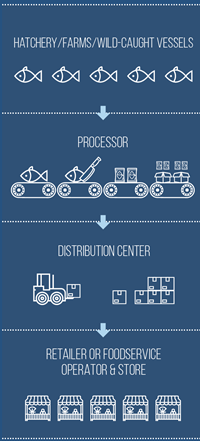
Source: IFT Global Food Traceability Center
As of 2018, supply chain and traceability solutions using blockchain technologies have only been implemented in limited pilot studies 3,6. Several companies have started to explore using open-source blockchain bases, such as Ethereum or IBM’s Hyperledger, for usage in supply chains1,6. Some of these pilot studies combine other technologies, such as internet-enabled sensors2.
Many of the benefits touted for blockchain enabled systems are not necessarily exclusive. By using a distributed system that is not implicitly owned by a particular entity, adopting common KDEs may be easier. However, it is possible to have KDEs that are harmonized across an industry while using more piecewise approaches to data collection and dissemination.
Challenges Ahead
The popularity of Bitcoin has revealed some drawbacks that will need to be addressed before being broadly applicable to industries like logistics or food traceability. One is the inherent compromises that exist in blockchain, such as limited transactions per second, which has created bottlenecks in exchanging information3,4,8. To scale a blockchain schema for an industry that processes thousands to millions of transactions a second, these types of bottlenecks are unacceptable8. There is also an issue with latency, or the time needed to append a block of data to the chain8.
As with any technology innovation, interoperability will be instrumental in ensuring implementation. For blockchain, that will mean agreeing on a common platform to be used throughout a given supply chain. After all, blockchain is merely enhancing the existing business and transactional relationships in an industry. There will also still be a need for standardizing KDEs.
As with any new technology, there are bound to be speculative businesses using blockchain technology as a dubious value-added service. For an analogy, e-commerce companies proliferated in the 1990s during the dotcom boom, but many made poor business decisions while too heavily relying on the promises of new technology, an infamous example being pets.com. Therefore, if one is investing in a blockchain technology to enhance traceability, it is important to have healthy skepticism on how effective blockchain is being implemented as a supply chain solution. Be wary of any promises that seem extraordinary. Cryptocurrencies are not strictly necessary to using blockchain in supply chains, so be especially skeptical about companies asking to invest in cryptocurrency.
Conclusions
Blockchain is not a silver bullet solution, especially to the sector of food traceability. Virtually every venture that is using blockchain technologies is still in its infancy, and there are many factors not dictated by technology that are affecting adoption. However, the potential for improved traceability by way of increased transparency, interoperability, and deinstitutionalization may prove invaluable to finding solutions among the issues in food traceability.
References:
The Economist. 2015. The Great Chain of Being Sure about Things. Available from: https://www.economist.com/news/briefing/21677228-technology-behind-Bitcoin-lets-people-who-do-not-know-or-trust-each-other-build-dependable.
Hyperledger. 2017. Seafood in Supply Chain Traceability Using Blockchain Technology. Available from: https://www.hyperledger.org/projects/sawtooth/seafood-case-study.
IBM. 2016. Hyperledger Architecture Working Group. Available from: https://www.hyperledger.org/wp-content/uploads/2017/08/Hyperledger_Arch_WG_Paper_1_Consensus.pdf.
Nakamoto S. 2008. Bitcoin: A Peer-to-Peer Electronic Cash System. Available from: http://nakamotoinstitute.org/Bitcoin/.
Pierro MD. 2017. "What Is the Blockchain?." Computing in Science & Engineering 19 (5): 92-95. doi: 10.1109/MCSE.2017.3421554.
Provenance. From Shore to Plate: Tracking Tuna on the Blockchain. Available from: https://www.provenance.org/tracking-tuna-on-the-blockchain.
Reijers W, O'Brolcháin F, and Haynes P. 2016. Governance in Blockchain Technologies & Social Contract Theories. Ledger 1: 134-151. doi: https://doi.org/10.5195/ledger.2016.62.
Tian F. 2017. A Supply Chain Traceability System for Food Safety based on HACCP, Blockchain & Internet of Things. 2017 International Conference on Service Systems and Service Management, Dalian, pp. 1-6. doi: 10.1109/ICSSSM.2017.7996119.
IFTNEXT

Episode 33: Global Food System Challenge Growth Grant Winners
Join us to celebrate the Global Food System Challenge Growth Grant Winners. Representatives from Food Systems for the Future (FSF Institute), iDE Global, and the African Center for Technology Studies discuss their work and the role that the generous funding from Seeding The Future Foundation plays in helping to make healthier diets more accessible and empowers consumers to make choices benefitting both personal and planetary health.

Episode 32: Global Food System Challenge Grand Prize Winners
Join us to celebrate the Global Food System Challenge Grand Prize Winners. Representatives from the International Rice Research Institute, Solar Freeze, and WorldFish discuss their work and the role that the generous funding from Seeding The Future Foundation plays in helping to make healthier diets more accessible and empowers consumers to make choices benefitting both personal and planetary health.

Episode 31: Promoting Sustainability and Mitigating Illegal Fishing with Seafood Traceability
Since 2017, IFT’s Global Food Traceability Center has worked with the World Wildlife Fund to advance a unified framework by convening seafood companies and other relevant stakeholders as part of the Global Dialogue on Seafood Traceability. We’ve convened this podcast to discuss the latest in traceability, particularly in the seafood industry.

